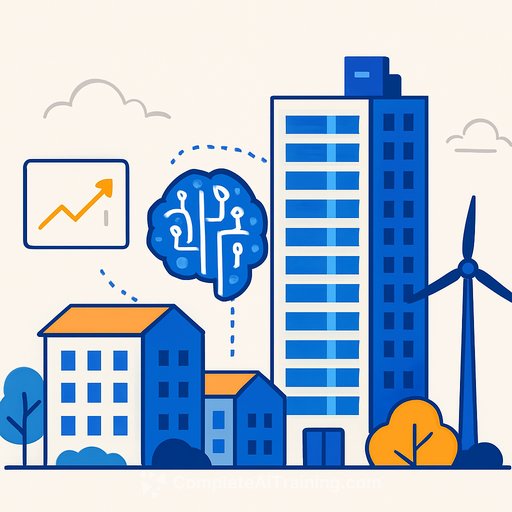AI Data Centers Put Private Credit Back in the Deal Flow
Private credit funds have raised record cash but struggled to place it. The AI data center build-out is opening the door. As banks retake large corporate loans, private credit is moving into long-duration, asset-backed infrastructure where speed, flexibility, and structuring matter.
Projects are scaling fast. The Stargate campus in Abilene, Texas-backed by OpenAI, Oracle, and SoftBank with promotional support from President Donald Trump-signals the scope. Meta selected PIMCO and Blue Owl to lead a $29 billion financing for its Louisiana expansion. Ares is targeting more than $8 billion across London, Japan, and Brazil. Real estate and construction teams that can deliver power, timelines, and certainty will win.
Why This Matters for Real Estate and Construction
AI data centers are capital-intensive boxes with utility-scale power needs and long leases from creditworthy tenants. That combination fits private credit's appetite and creates a durable pipeline for developers, GCs, and specialty subs.
- Large, repeatable programs: multi-site rollouts instead of one-off jobs.
- Clear revenue anchors: hyperscaler contracts de-risk cash flows.
- Premium for delivery: teams that de-risk power and schedule command better terms.
Where the Money Is Moving
Expect concentration around power-rich, fiber-connected, incentive-friendly locations. Recent activity highlights:
- United States: Louisiana (Meta expansion) and Texas (Abilene's Stargate campus).
- United Kingdom: Greater London corridors with existing fiber and substations.
- Japan: Chiba and greater Tokyo zones with established connectivity.
- Brazil: São Paulo metro with growing hyperscaler demand.
What Private Credit Wants to See
- Power locked: Interconnect status, substation plan, transformer lead times, and backup generation.
- Anchor demand: Signed offtake or late-stage LOIs from hyperscalers, with ramp schedules.
- Schedule certainty: EPC contracts, critical path mapping, liquidated damages, and contingency budget.
- Unit economics: MW build cost, PUE targets, operating expense model, and indexation clauses.
- Permitting path: Zoning, environmental, water use, and noise-documented and sequenced.
- Exit options: Sale-leaseback, refinancing takeout, or perpetual hold with stable cash yields.
Financing Structures You'll See
- Construction loans with delayed-draw features tied to MW milestones.
- Unitranche debt for speed and simplicity on programmatic builds.
- Mezzanine or preferred equity to bridge cost overruns or accelerate phases.
- Sale-leaseback on stabilized shells, with separate equipment financing for MEP.
Design and Delivery Priorities (That Win Mandates)
- Electrical first: Medium-voltage gear, UPS architecture, N+1/N+2 redundancy, and arc-flash safety.
- Cooling evolution: Air-to-liquid transitions for high-density racks; plan for higher W/sq ft.
- Standardization: Repeatable pods, modular skids, and prefabrication to compress schedules.
- Fiber concurrency: Diverse paths, cross-connects, and dark fiber options planned early.
- Operations handoff: Clear testing/commissioning, integrated BMS/EPMS, and SLA-ready playbooks.
Risk Controls Lenders Now Expect
- Evidence of grid queue position and realistic energization dates.
- Transformer and switchgear procurement locked within 30-60 days of NTP.
- Contingency of 10%-15% for MEP packages; commodity hedging where sensible.
- Community strategy for noise, water usage, and traffic during construction.
- Step-in rights, cash sweeps, and KPI reporting tied to MW delivered and uptime.
How Developers and GCs Can Position
- Lead with power: show substations, line routes, and utility MOUs before design flair.
- Package certainty: EPC alignment, equipment reservations, and commissioning plans in one binder.
- Offer options: phased builds (10-20 MW chunks) with shell/core ready for density upgrades.
- Speak the metrics: MW per month, PUE band, rack density roadmap, and time-to-energize.
- Bring partners: fiber carriers, cooling specialists, and OEMs pre-aligned for volume.
Market Signals to Track
- Interconnection backlogs and utility capacity releases.
- Hyperscaler RFP cadence and preferred regions.
- Local incentives for power infrastructure and job creation.
- Cooling tech shifts that change floorplate and MEP layouts.
Demand can move faster than power. Align site control, grid timelines, and tenant ramps before chasing financing. The teams that de-risk those three inputs will stay busy through this build cycle.
For context on energy supply and demand pressures, see the International Energy Agency's work on data center electricity use here. If your team needs to level up on AI concepts to win client trust, explore role-based learning paths at Complete AI Training.
Your membership also unlocks:






